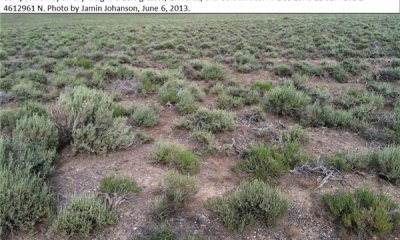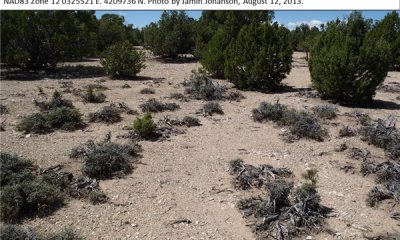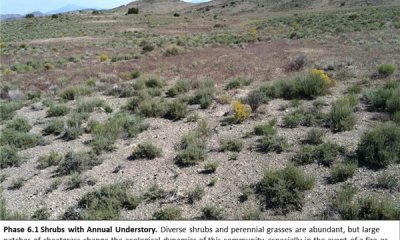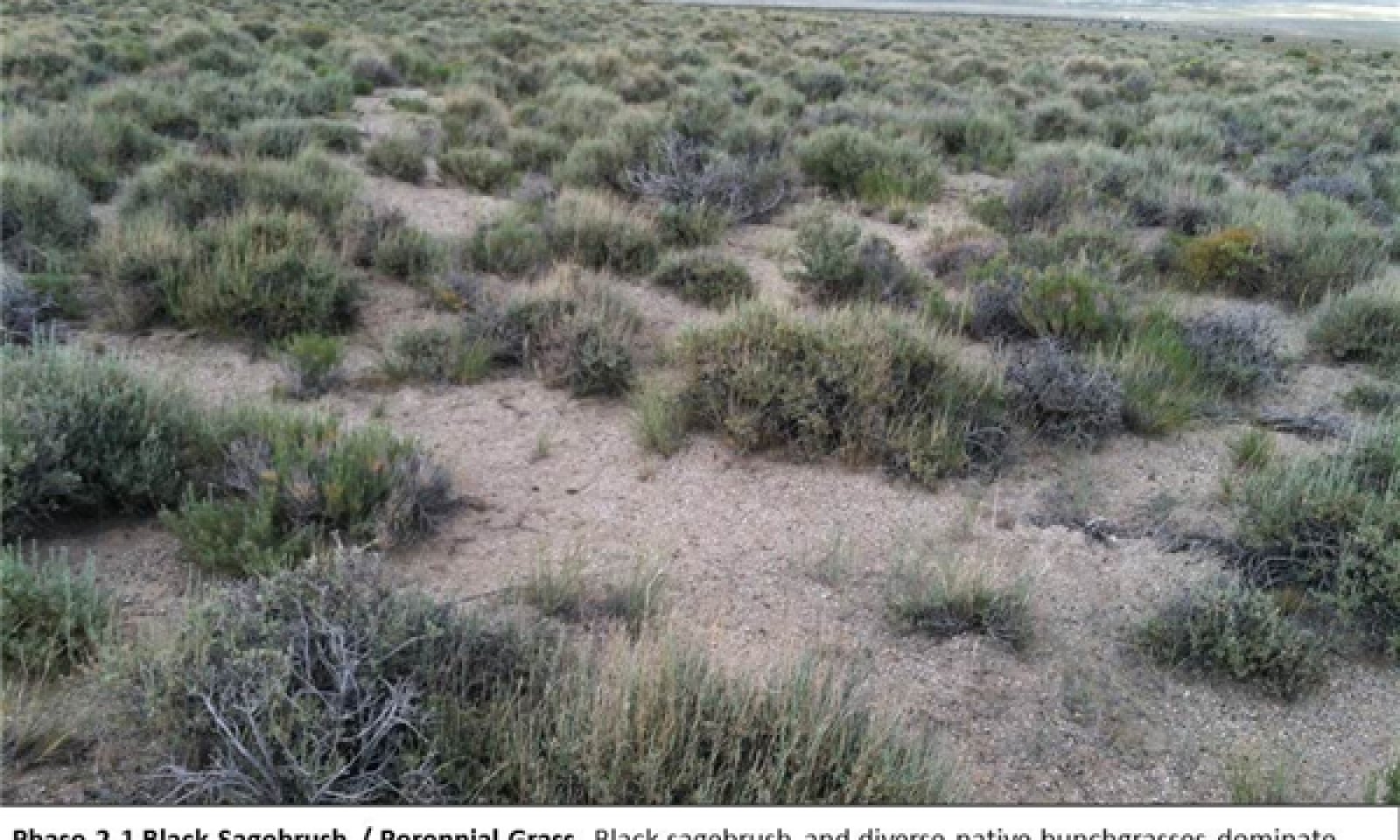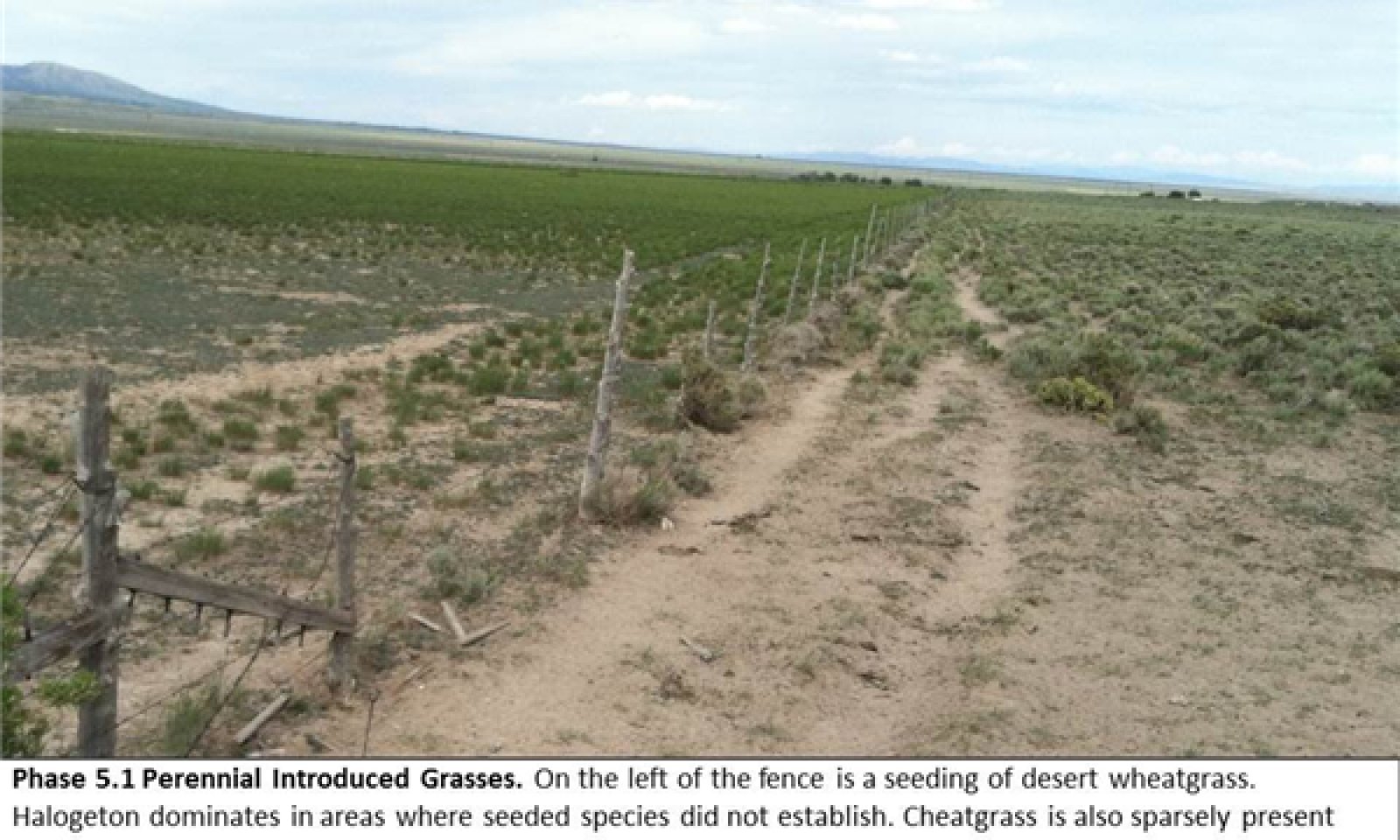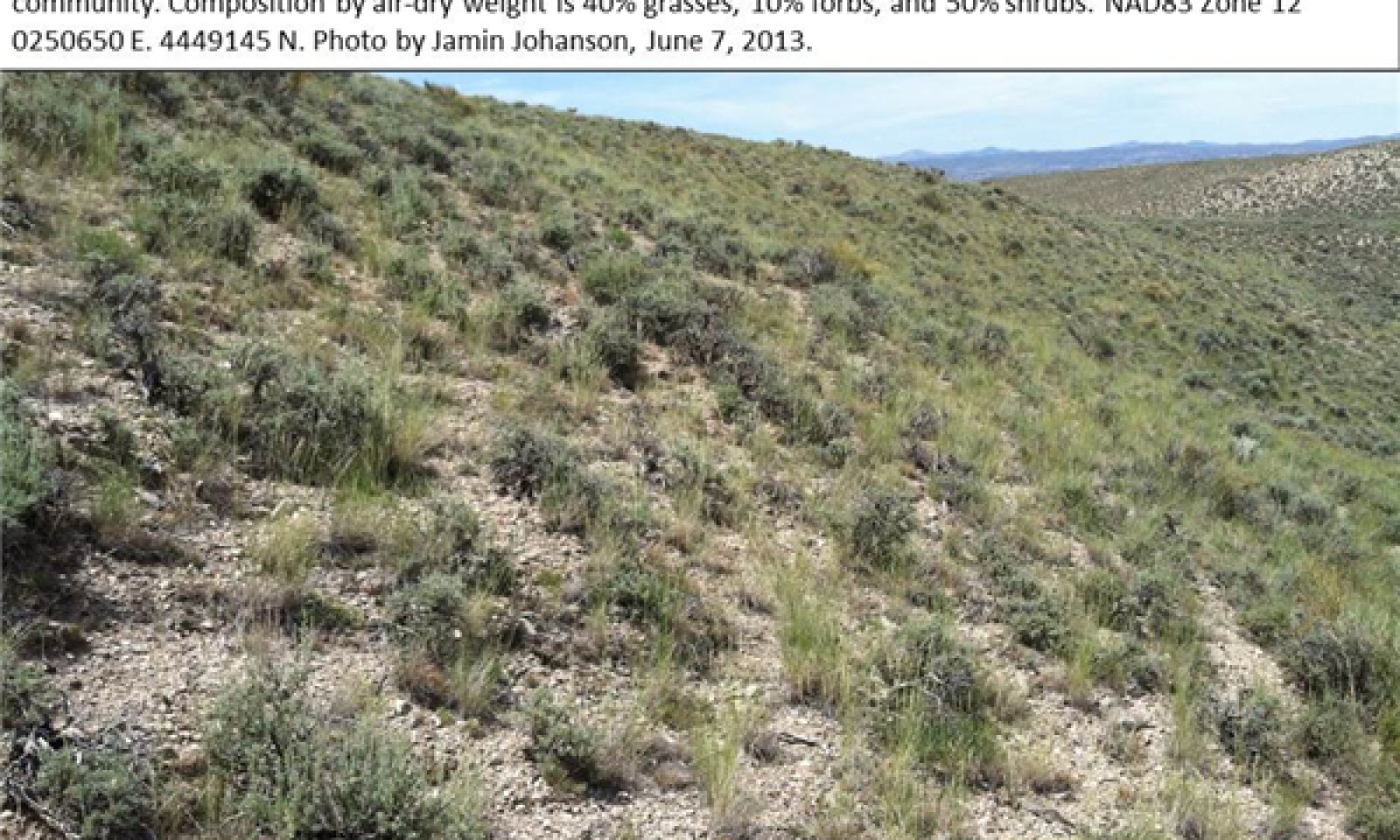
Semidesert Shallow Hardpan (Black Sagebrush)
Scenario model
Current ecosystem state
Select a state
Management practices/drivers
Select a transition or restoration pathway
- Transition T1a More details
- Transition T2a More details
- Transition T2b More details
- Transition T2c More details
- Transition T3a More details
- Transition T3b More details
- Transition T3c More details
- Transition T4a More details
- Transition T5a More details
- Transition T5b More details
-
No transition or restoration pathway between the selected states has been described
Target ecosystem state
Select a state
Description
The plant community dynamics of the reference state are driven primarily by climate and fire. Black sagebrush dominates the overstory and perennial cool-season grasses dominate the understory for most of the time on this site. However, periodic fires remove black sagebrush and increase perennial grasses, which dominate the site for several years before black sagebrush slowly establishes and increases in the community.
The fire return interval for this site is expected to be 150-250 years for stand-replacing fires, and 75-100 years for mixed severity fires. Wet years followed by an average or dry year increases the likelihood of fire on this site due to increased fuel loads and dry conditions. The sparse vegetation on this site contributes to the relatively long fire return interval, as compared to big sagebrush sites (Artemisia tridentata) in the Great Basin that have a much shorter fire return interval.
In the absence of fire, Utah juniper can establish and increase on this site, usually after a period of about 75 years following fire. Adjacency to juniper stands and extended wet periods increase the likelihood and shorten the timeframe of juniper encroachment onto this site. As juniper increases in the plant community, black sagebrush and perennial grasses are expected to decrease somewhat. However, the presence of juniper in the community increases the likelihood of stand-replacing fire, which results in a perennial grass dominated community.
Submodel
Description
The Invaded State is similar to the Reference State in species composition and in the fundamental ecological processes, but allows for non-native species to be present. During wet periods, non-native invasive annuals, particularly cheatgrass, may increase temporarily in the community, but they decrease in abundance during dry periods. The addition of non-native species and modern disturbance regimes reduces the overall resillience of state 2 compared to state 1, so State 2 also includes two at-risk plant communities.
Phase 2.3 is at-risk of transitioning to a Juniper State (state 4) as shrubs and grasses lose their ability to propogate themselves in the community.
Phase 2.3 includes Utah juniper as a component of the plant community, but fire suppression and removal of fine fuels by livestock reduce the likelihood of fire (pathway 2.3a). When the lack of fire extends beyond the 150-250 year fire return interval, juniper begins to dominate the ecological processes and can cross the threshold out of State 2 and into State 4.
Phase 2.4 is at-risk of transitioning to a Sagebrush/Depleted Understory State (State 3)because, although it still has some perennial grasses in the understory, they are losing vigor and decreasing in the community. When perennial grasses lose their ability to propagate themselves in the community, Phase 2.4 will transition to a sagebrush-dominated state without the co-dominant herbaceous understory.
Submodel
Description
The depleted understory state is characterized by an overstory dominated by black sagebrush, and an understory that is either very sparse or dominated by Sandbergs bluegrass. Few formerly-dominant perennial grasses may still be present under shrubs, but they are so few that they are unable to increase in the community. Invasive annuals, such as cheatgrass, may be present, but are also sparse. This state is susceptible to an increase in Utah juniper and/or cheatgrass, especially during wet periods. The removal of livestock from this state will not result in a natural increase in perennial grass production due to the lack of perennial grass seed in the seedbank.
Submodel
Description
This state is dominated by Utah junipers. Shrubs and perennial grasses, if present, are decreasing in the plant community with very little or no recruitment of young plants. The lack of fine fuels in this state greatly reduce the likelihood of fire, thus perpetuating juniper dominance on the site. This state occurs in areas where the 75-150 year fire return interval is greatly exceeded due to fire suppression and or fine fuel removal by livestock. The likelihood of transitioning to this state is increased when a juniper stand is nearby. In some areas far from a juniper seed source, this state may not occur within the timeframes referenced in this document.
Submodel
Description
The seeded range state is characterized by the abundance of non-native perennial grass species. Successful seedings result in productive stands of crested wheatgrass, Russian wildrye, or similar species. Native plants, particularly shrubs, can re-establish in these seedings after several decades. Unsuccessful seedings often result in a mixed plant community with diverse proportions of sprouting shrubs (e.g. rabbitbrush), perennial grasses, and annual forbs and grasses. Unsuccessful seedings are at-risk of transitioning to an annual state (State 6), but may also self-repair to some extent if shrubs and perennial grasses increase.
Submodel
Description
The annual dominated state is characterized by the abundance of cheatgrass. Other invasive annual species may be present, but cheatgrass is the species that alters the ecological processes of this site by increasing the fire frequency. The plant community may have some shrubs, but the fine fuels associated with cheatgrass increase the fire frequency such that shrubs do not regain dominance. Over time, the nutrient pools of the site, which were once deep and patchy under shrubs, become homogenized near the soil surface. These changes in disturbance regime and nutrient dynamics facilitate increasing cheatgrass dominance, and contribute to the improbability of transitioning out of this state.
Submodel
Mechanism
This transition results from establishment by invasive species, usually in combination with other modern disturbances such as recreation and livestock grazing, which may provide seed sources and germination sites for non-native species. However, the two primary invaders on this site, cheatgrass and Russian thistle, can establish on this site in the absence of major disturbance.
Mechanism
This transition occurs as the dominant perennial grass species are lost from the plant community. Sandbergs bluegrass may increase in the understory and become the dominant herbaceous species if present. Black sagebrush also increases and dominates the site, while annual invasive species like cheatgrass are present but not abundant. This transition is most commonly the result of excessive livestock grazing during the growing season such that the apical meristems of perennial grasses are repeatedly removed, killing the plants.
Mechanism
This transition occurs as Utah juniper increases in the community and dominates the ecological processes of the site. Perennial grasses and shrubs decrease in the community as older plants die out and new shrub and grass seedlings, if present, are inhibited by juniper dominance. Juniper may dominate the site by a combination of shading, competition for water and nutrients, and/or allelopathy. This transition is facilitated by fire supression and/or a combination of livestock grazing and drought that removes the fine fuels necessary to carry fire. The fire return interval is extended well-beyond 150 years.
Mechanism
This transition occurs when perennial non-native grass seed is introduced to the site, usually by mechanical seeding directly into the soil. Under favorable seeding conditions, when spring soil moisture is sufficient for germination and establishment of seeded species, this site is capable of supporting productive stands of crested or desert wheatgrass. Russian wildrye has been established on this site under irrigated conditions. Unfavorable seeding conditions, where spring soil moisture is insufficient for germination and establishment of seeded species, often result in an unusual mix of perennial and annual grasses and forbs along with sprouting shrubs. This transition is facilitated by human intervention with mixed, unpredictable rates of success.
Mechanism
This transition occurs as Utah juniper increases in the community and dominates the ecological processes of the site. Shrubs decrease in the community as older plants die out and new shrub and seedlings, if present, are inhibited by juniper dominance. Juniper dominates the site by a combination of shading, competition for water and nutrients, and/or allelopathy. This transition is facilitated by fire supression and/or a combination of livestock grazing and drought that removes the fine fuels necessary to carry fire. The fire return interval is extended well-beyond 150 years.
Mechanism
This transition occurs when perennial non-native grass seed is introduced to the site, usually by mechanical seeding directly into the soil. Under favorable seeding conditions, when spring soil moisture is sufficient for germination and establishment of seeded species, this site is capable of supporting productive stands of crested or desert wheatgrass. Russian wildrye has been established on this site under irrigated conditions. Unfavorable seeding conditions, where spring soil moisture is insufficient for germination and establishment of seeded species, often result in an unusual mix of perennial and annual grasses and forbs along with sprouting shrubs. This transition is facilitated by human intervention with mixed, unpredictable rates of success.
Mechanism
This transition occurs as cheatgrass increases on the site in one of two ways. Cheatgrass may establish in the understory during wet periods and gradually increase in abundance and seed production to the point of becoming a dominant understory species, or, cheatgrass may establish on the site following fire or other disturbance that removes shrubs. Fire size can range from small to large, and fire intensity can range from low intensity to stand-replacing. Mechanical removal or other shrub removal events also facilitate cheatgrass establishment by opening up germination sites for annual seeds, particularly in areas where soil is disturbed. Even small patches of cheatgrass dominance are indicators of this transition, since they can produce enough seed to ensure the spread and eventual dominance of cheatgrass on the site.
Mechanism
This transition is expected to occur in the event of a stand-replacing fire that removes Utah juniper. It assumes that a mix of early seral species, including cheatgrass, will establish on the site initially until cheatgrass eventually gains dominance of the site.
Mechanism
This transition occurs when perennial grasses are decreased in the community, while black sagebrush increases.
Model keys
Briefcase
Add ecological sites and Major Land Resource Areas to your briefcase by clicking on the briefcase (![]() ) icon wherever it occurs. Drag and drop items to reorder. Cookies are used to store briefcase items between browsing sessions. Because of this, the number of items that can be added to your briefcase is limited, and briefcase items added on one device and browser cannot be accessed from another device or browser. Users who do not wish to place cookies on their devices should not use the briefcase tool. Briefcase cookies serve no other purpose than described here and are deleted whenever browsing history is cleared.
) icon wherever it occurs. Drag and drop items to reorder. Cookies are used to store briefcase items between browsing sessions. Because of this, the number of items that can be added to your briefcase is limited, and briefcase items added on one device and browser cannot be accessed from another device or browser. Users who do not wish to place cookies on their devices should not use the briefcase tool. Briefcase cookies serve no other purpose than described here and are deleted whenever browsing history is cleared.
Ecological sites
Major Land Resource Areas
The Ecosystem Dynamics Interpretive Tool is an information system framework developed by the USDA-ARS Jornada Experimental Range, USDA Natural Resources Conservation Service, and New Mexico State University.


